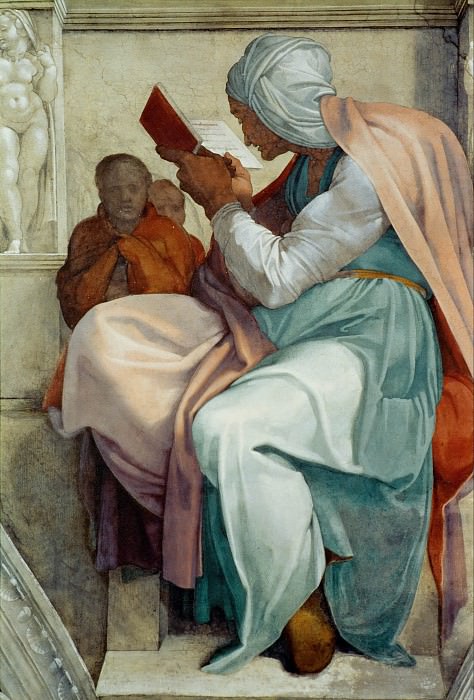The Persian Sibyl Michelangelo Buonarroti (1475-1564)
Michelangelo Buonarroti – The Persian Sibyl
Edit attribution
Download full size: 2437×3600 px (1,0 Mb)
Painter: Michelangelo Buonarroti
Location: Vatican Museums (fresco) (Musei Vaticani (murales)), Vatican.
Unlike the Libyan Sibyl, her "fellow diviner," the Persian Sibyl lived in the East, as can already be understood from her name. She bore the name Sambetta, and was also called the Babylonian prophetess. Mentions about her belong to the 13th century B. C., to the same period, namely to 1248 B. C. the prophecies of the famous Sibylline belong, which she drew from her books, numbering up to 24 pieces.
Description of Michelangelo Buonarroti’s painting The Persian Sibyl
Unlike the Libyan Sibyl, her "fellow diviner," the Persian Sibyl lived in the East, as can already be understood from her name. She bore the name Sambetta, and was also called the Babylonian prophetess.
Mentions about her belong to the 13th century B. C., to the same period, namely to 1248 B. C. the prophecies of the famous Sibylline belong, which she drew from her books, numbering up to 24 pieces. It is believed that in them there are prophecies concerning the life and deeds of Jesus Christ, as well as Alexander the Great and other legendary figures. They were expressed in the form of verses with the double meaning which does not give unequivocal interpretation.
According to the descriptions of contemporaries, the Persian Sibylline wore golden robes and had a youthful disposition. In a fresco in the Sistine Chapel by Michelangelo Buanarotti, Sambetta appears in a rather advanced age. The woman sits, almost completely turned away from the viewer, with her face close to the unchanging book.
Perhaps it is at this moment that the Persian Sibyl reads her next prophecy, all of which were imbued with mystery and centuries-old eastern wisdom. What is hidden in them, what do they promise to the listener - sorrow and grief, or perhaps joy and happiness? Sambeta has become old, her eyes are not as good as in her youth, but her mind is still sharp and clear.
As always in Michelangelo’s work, bright and saturated tones prevail in the portrayal of the Sibylline, emphasizing the wealth, quality and excellent quality of the Persian fortuneteller’s garments.
She still has the inner power that all five of the Sibyls had, and the great painter Buanarotti is undoubtedly credited with conveying the characters of the diviners with unparalleled precision, using not words but brushes and paints.
Кому понравилось
Пожалуйста, подождите
На эту операцию может потребоваться несколько секунд.
Информация появится в новом окне,
если открытие новых окон не запрещено в настройках вашего браузера.
You need to login
Для работы с коллекциями – пожалуйста, войдите в аккаунт (open in new window).




















You cannot comment Why?